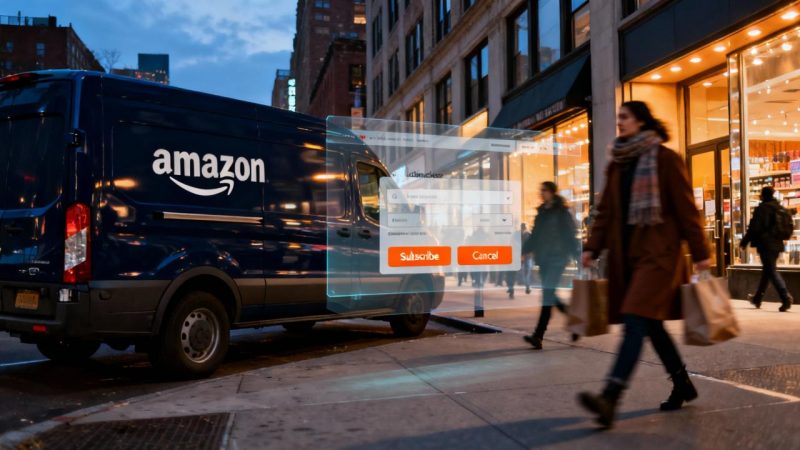A historic penalty exposes how the internet’s biggest storefront turned UX into a profit center — and what regulators finally did about it.

Amazon will pay $2.5 billion to settle the Federal Trade Commission’s lawsuit alleging it “tricked” millions into Prime memberships and then made quitting maddeningly hard. The deal splits into a $1 billion civil penalty and $1.5 billion in consumer redress, with sweeping changes to how Amazon can pitch and cancel Prime going forward. The FTC called it the largest civil penalty tied to an agency rule violation and a “monumental win” for consumers, and the Commission approved it 3-0 before filing in federal court in Seattle. The order also ropes in two executives by name, a rare step in subscription‑trap cases. That’s not nothing — it’s a signal to the rest of Big Tech that “dark patterns” are no longer just clever growth hacks; they’re legal liabilities. FTC press release
The topline numbers matter, but the mechanics matter more. The FTC says Amazon used manipulative interfaces that nudged shoppers into auto‑renewing Prime during checkout, obscured key terms, and erected a multi‑step obstacle course to cancel. Amazon denies wrongdoing and admits no liability — a standard corporate refrain — while insisting it already offered clarity and easy cancellation. But a case that was three days into a jury trial — unusual for this kind of consumer‑protection fight — ends with Amazon writing the biggest check of its kind and agreeing to redesign basic flows. That’s the market speaking, too.
What Changes Now
Start with the most practical bit: money back. The FTC estimates roughly 35 million customers could be eligible for refunds, with payments up to around $51 depending on use of Prime benefits during the eligibility period. Some will receive automatic refunds; others will need to file claims. The agency says Amazon must explain the program clearly and finance an independent supervisor to monitor distribution. And crucially, no more “No, I don’t want free shipping” decoy buttons — any decline must be clear, not a guilt trip in disguise.
The order also hits Amazon where it quietly held the most leverage: the off‑ramps. Amazon must create an easy cancellation path using the same method customers used to sign up. If one click got you in, one click should get you out. That’s a direct response to what the FTC says was a deliberate thicket of screens and steps. Internally, Amazon’s off‑ramp project was reportedly code‑named “Iliad,” a not‑subtle nod to Homer’s epic about long, grinding battles — precisely the point regulators say consumers faced when trying to quit.
Why This Case Landed So Hard
You can read this as a consumer‑protection story. It’s also a democracy story. A handful of platforms now mediate essential parts of daily life — shopping, payments, information — and when they use asymmetries of power and data to steer our choices, we’re not in a marketplace; we’re in a maze we didn’t design. That’s the logic behind laws like ROSCA, the Restore Online Shoppers’ Confidence Act, which the FTC invoked here. The internet didn’t invent fine print and upsells. But it did industrialize them at scale.
The politics are notable, too. The case was filed in 2023 and pushed forward across administrations and chairs. Today’s FTC leadership framed the win as part of a broader crackdown on manipulative subscription design, and the Commission’s unanimous vote suggests a rare institutional consensus on the problem. The institutional message: consumer consent is either real or it’s not. If your business model depends on making “no” hard to say, regulators will say “no” for you.
Amazon’s Defense — and Its Real Risk
Amazon’s core defense is familiar: Prime’s value is obvious, the disclosures are clear, and customers can cancel whenever they want. Also true: Prime is a profit engine. It juiced $44 billion in subscription revenue last year by some estimates, and Prime members spend more, more often. That’s exactly why the architecture of choice matters — tiny frictions are not neutral when multiplied across 200 million members globally.
The immediate financial hit is manageable for a $2‑plus trillion company. The strategic risk is precedent. This judgment puts “subscription traps,” “auto‑renew consent,” and “dark patterns” into a high‑visibility compliance bucket with clear, enforceable boundaries. Other apps with friction‑by‑design off‑ramps — streaming platforms, fitness apps, news sites — should assume their flows will now be compared to the Amazon order line by line.
It also lands as Amazon faces a bigger antitrust war with the FTC, alleging the company leverages market power to punish sellers and tilt the marketplace. That case is slated for trial in 2027. If this settlement is about how Amazon treats customers, the next one is about how it treats the entire ecosystem around it. Both implicate the same thing: power without accountability.
The Bigger Lesson: Design Is Policy
Let’s drop the fiction that user interface is an apolitical layer. Design choices are economic choices; they allocate time, attention, and money. The FTC’s order reads like a product spec for ethical enrollment: clear pricing and renewal terms, conspicuous opt‑outs, easy exits. It will nudge the industry toward a baseline that makes consent legible again.
Progressives have been arguing for years that democratic norms don’t survive contact with extractive platform design. You don’t protect autonomy in the abstract; you protect it by banning the tricks that erode it. This settlement doesn’t end the arms race between growth teams and regulators, but it changes the cost calculus. For once, the cheapest option isn’t the dark one.
If you’re a Prime member wondering “Do I get anything?”: yes, if you were swept into a membership or delayed cancellation between mid‑2019 and mid‑2025, you may qualify for a refund, and some customers will receive automatic payments. Amazon will publish details on its site as part of the order’s compliance plan. That’s not charity. It’s accountability — long overdue, and now enforceable.
